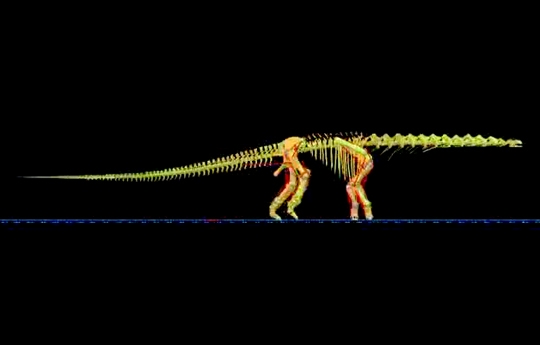IIPByG
Tracing the steps of a giant
Argentine and British researchers digitally recreated the gait of the Argentinosaurus huinculensis, a forty metres long and eighty tonnes dinosaur.
How could these animals move around in spite of their size? This is the question that a group of scientists of different countries tried to answer. Among them was Rodolfo Coria, Independent researcher of CONICET at theInstituteofPaleobiologyand Geology (IIPByG, UNRN).
For about a hundred years, graphic reconstructions about paleontological topics were made with the proviso that until recent they were created from conceptions of artists, sculptors and animators with the support of paleontologists. Nevertheless, the idea is to stop using only imagination and provide the recreation with empirical data.
For this purpose, software engineers joined paleontologists to generate a model that responds to real information and thus confirm or eliminate previous attempts.
“The aim of our project is to test a programme designed by William Irvin Seller, the original author of the work. This software uses digital models obtained from the remains of the skeleton of the Argentinosaurus and includes information about the joints’ angles, the relations and distances among them and the other bones. The programme processes this information, produces a mathematical algorithm and proposes a digital model of the dinosaur moving”, Coria says.
The Argentinosaurus – whose skeleton is at theCarmenFunesMuseum in Plaza Huincul,Neuquén,Argentina-, was scanned through a modeling and simulation technique that involved the power equivalent to 30,000 home computers. “We’ve recreated its ability to move and proved, for the first time, that it was able to walk slowly but firmly”, Seller explains.
According to Coria, the mechanical locomotion of the cretaceous dinosaur is similar to the elephants’ and they reached an average travelling speed of6 kilometresper hour or, in other words,2 metresper second. “This speed is like a semi quick step of men. When people go for a walk in the park, they reach a speed of 5 km/hs”, Coria comments.
The researchers ensure that although the dinosaur had the ability to walk and move around it was limited to its locomotor capability, what caused significant problems to develop other activities such as rapid reaction when trying to escape, sudden body rotations, or to keep bipedal standing for no more than a few seconds.
“Our automatic learning system only works with the available information about dinosaurs and predicts the best possible motion patterns”, Sellers explains.
Both scientists agree on the fact that this type of research is important in order to understand more about musculoskeletal systems and for the development of robot technology.
The research team of the University of Manchester is planning to use this innovative method to recreate the gait of other dinosaurs such as Triceratops, Brachiosaurus and the Tyrannosaurus rex.
- By: Jimena Naser
- About research:
- Rodolfo Coria: independent researcher
- William Irvin Seller: Manchester University. England
